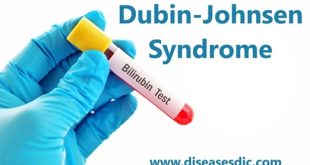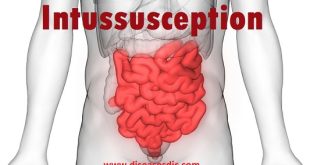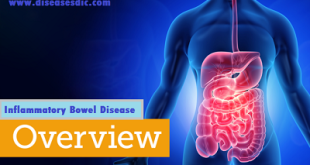Definition
Dumping syndrome (DS) is also referred to as rapid gastric emptying and occurs when food is passed directly from your stomach pouch to the first part of the small intestine without undergoing digestion. It is frequently related to the rapid emptying of hyperosmolar gastric content into the small bowel. Although the precise mechanism of DS is not known, dumping is a phenomenon usually caused by the destruction or bypass of the pyloric sphincter. DS can occur in post–gastric bypass patients when high levels of simple carbohydrates are ingested. The condition can also develop in people who have had esophageal surgery. Clinically significant dumping symptoms occur in about 20% of patients after pyloroplasty or distal gastrectomy. Patients younger than age 35 years or with a BMI <25 kg/m2 are more likely to be symptomatic than are older or more obese patients.
It is believed that the osmotic gradient draws fluid into the intestine, and this may release one or more vasoactive hormones, such as serotonin and vasoactive intestinal polypeptide. Most people with DS develop abdominal cramps and diarrhea within 10 to 30 minutes after eating. Others experience such symptoms 1 to 3 hours after eating, and yet others experience both early and late symptoms.
Epidemiology
In patients who have undergone gastric surgery, an estimated 20% to 50% of patients have symptoms of Dumping syndrome. Patients develop severe symptoms approximately at a rate of 1 to 5%. Early Dumping syndrome appears to have a higher incidence compared to late Dumping syndrome.
Pathophysiology
The stomach acts as a food reservoir, beginning the digestion process by secreting gastric acid and enzymes and then grinding the food into smaller portions (around 1–2 mm) through organized muscular contractions (see image). This partially digested food then passes through the pylorus into the duodenum. The pyloric sphincter ensures that only small food particles gradually pass into the duodenum so as not to overload the small intestine’s ability to properly digest and absorb food.
Gastric surgeries often reduce the storage capacity of the stomach, remove the gastric glands, and damage the pylorus so that it becomes unable to control the rate of passage of food into the duodenum, causing the stomach to empty rapidly. This increased gastric emptying is one of the main symptoms of dumping syndrome.
Types
Early Dumping Syndrome
Early dumping syndrome (EDS) occurs between 30 to 60 minutes after a person has eaten. It has been long suggested that EDS symptoms happen due to hyperosmolar gastric content in the small intestinal lumen causing fluid to be pulled from the intravascular compartment into the small bowel lumen.
This fluid shift causes rapid distension of the small bowel, which leads to associated symptoms such as bloating, diarrhea, nausea and abdominal pain. There is also an increase in the number of bowel contractions. In addition to the GI symptoms, intravascular volume depletion causes lightheadedness and an increase in heart rate.
Late Dumping Syndrome
Late dumping syndrome (LDS) happens anywhere between 1 to 3 hours after a meal. LDS is believed to be due to an overwhelming increase in insulin secretion that leads to reactive hypoglycemia (i.e. low blood sugar level). The exaggerated rise of insulin occurs due to the rapid transit of carbohydrates to the small intestines and the subsequent quick absorption of this glucose.
To counter the effects of high glucose concentrations, the body secretes more insulin than usual (hyperinsulinemia) which remains for an extended period, causing hypoglycemia. The signs and symptoms that occur as a result of hypoglycemia include sweating, tremors, weakness, heart palpitations, nausea, dizziness, aggression, confusion and loss of consciousness.
Risk factors of Dumping Syndrome
Surgery that alters your stomach can increase your risk of dumping syndrome. These surgeries are most commonly performed to treat obesity, but are also part of treatment for stomach cancer and other conditions. These surgeries include:
- Gastrectomy, in which a portion or all of your stomach is removed.
- Gastric bypass surgery (Roux-en-Y operation), which is performed to treat morbid obesity. It surgically creates a stomach pouch smaller than the stomach, meaning you’re no longer able to eat as much as you once did. It connects the small intestine to this pouch in the form of a gastrojejunostomy.
- Esophagectomy, where all or part of the tube between the mouth and the stomach is removed.
Dumping Syndrome Causes
Dumping syndrome can occur after any type of stomach, gastric, or esophageal surgery. After you eat, food and gastric juices move from the stomach to the small intestine. However, in a patient that has dumping syndrome, food and juices move too quickly into the small intestine, which can cause discomfort and pain. Any surgery that changes the composition of your stomach can put you at risk for dumping syndrome. These surgeries include:
Gastric bypass surgery (Roux-en-Y operation): This is an operation used when a patient is morbidly obese. It creates a pouch to make the size of the stomach smaller, so the patient can eat less food in a sitting. This pouch connects to the small intestine (a procedure known as gastrojejunostomy).
Gastrectomy: This is a procedure where your stomach is removed in part or in full and is performed for a number of different reasons, such as stomach cancer.
Esophagectomy: This surgery involves the removal of all or part of the esophagus or esophageal tract.
Many of these surgeries are performed to aid in weight loss, but there may be other reasons these surgeries are performed, such as cancer. Other surgeries can contribute to dumping syndrome, but these are the most common culprits.
Symptoms
Most people experience dumping symptoms immediately following a meal. In some patients symptoms can occur one to three hours after eating. In either case, symptoms can range from mild to severe.
The following symptoms may occur during a meal or 15-30 minutes following a meal.
- Bloating
- Belching
- Nausea
- Abdominal pain, cramps
- Diarrhea
- Dizziness, lightheadedness
When symptoms develop 1-3 hours after eating they may include:
- Weakness, fatigue
- Low blood sugar
- Sweating
- Diarrhea
- Shakiness
- Anxiety
- Heart palpitations
- Fainting
- Mental confusion
Complications of Dumping Syndrome
Dumping syndrome is a complication of stomach bypass or stomach reduction surgery. Other complications related to this surgery include:
- Poor nutrient absorption
- Weakened bones, called osteoporosis, from poor calcium absorption
- Anemia, or a low red blood cell count, from poor absorption of vitamins or iron
Diagnosis and test
Physicians diagnose dumping syndrome based on individual symptoms and the results of one or more diagnostic procedures. These may include:
Oral glucose tolerance test: This test measures your body’s ability to absorb glucose or sugar – a form of energy. It is performed in a physician’s office or medical laboratory and can take up to six hours to complete. Fasting is required beforehand.
Gastric emptying test: This test involves eating a bland food with a minute trace of radioactive material. A radiologist tracks this material at hourly intervals using non-invasive imaging technology as the food moves through your system. The rapidity with which it progresses can indicate whether your body is “dumping” stomach contents.
Upper GI endoscopy: An endoscope is a tiny camera with a light that a gastroenterologist inserts into your stomach or small intestines by means of a long flexible tube through your mouth. He or she uses this camera to inspect for evidence of a medical condition. Though not a surgical procedure, endoscopy typically requires some type of anesthesia.
Upper GI series: Also called a barium swallow, an upper GI series is a non-invasive means of monitoring activity in your small intestines. You drink chalky liquid containing barium, the progress of which is charted by X-rays. Physicians use this information to diagnose medical issues involving the intestines. Fasting may be required prior to an upper GI series.
Treatment and medications
Treatment for the dumping syndrome includes lifestyle/dietary changes, medications and in severe cases need surgery.
Lifestyle/Dietary advice for dumping syndrome
The Following dietary advice can help to manage both early and late dumping syndrome:
- Have smaller meals: Small meals will make you feel full and are easier to digest. Eat 5 or 6 small meals each day instead of 3 large ones. Be sure to eat slowly and chew your food well.
- Do not drink fluids with meals: Fluids increase the speed at which your food passes through your stomach and into your intestine. Avoid drinking for about 30 minutes before and after eating.
- Avoid High Sugar foods: This includes foods such as soft drinks, flavoured milk, lollies, sweetened juices, sports drinks, cookies and cakes. When consuming carbohydrates, go for complex carbohydrates, such as vegetables and multigrain options.
- Include protein with each meal and snack: This will help to slow the rate of the stomach emptying. Protein examples include eggs, meat, chicken, fish, legumes, nuts, tofu and peanut butter.
- Include high fibre foods: Soluble fibre, found in legumes, oats, fruit and vegetables is most helpful. A fibre supplement such as benefibre/Metamucil, will also help. Begin with adding 1 teaspoon in a food/drink at breakfast, lunch and dinner, increasing to 2-3 teaspoons three times daily. Always ensure adequate fluid intake (at least 1.5L per day).
- Avoid foods which you know cause symptoms for you: Some people find certain foods, for example milk products or caffeine trigger symptoms.
- Avoid alcohol: It may disturb the usual digestion and may aggravate your symptoms.
- Add vitamins, iron and calcium supplements: Sometimes people with damping syndrome may deplete following stomach surgery. Thus adding this as supplement helps to avoid malnutrition.
- Lie down immediately after eating: This may slow the digestion as well as dumping into your intestines.
Dumping syndrome medication
Once your dumping syndrome lifestyle/dietary changes failed to produce the expected results, then you need medications or surgery to manage the problem effectively. There are certain medications to slow down the food passage out of the stomach, which helps to provide relief the symptoms associated with dumping syndrome.
The medications often used for the dumping syndrome are:
- Acarbose (Precose) – It is a type 2 diabetes medication. This medication delays the digestion of carbohydrates, thus may help to relief your dumping symptoms. Some common side effects of acarbose are sweating, headaches, sudden hunger and weakness.
- Octreotide (Sandostatin) – It is an anti-diarrhea medication helps to slow down the emptying of stomach contents into the small intestine. You have to take this as an injection under your skin (subcutaneously). Get trained for the proper way to self-administer this medication, including optimal sites for injection. Some common side effects of octreotide are diarrhea, bulky stools, gallstones, flatulence, bloating. Thus, consider this medication only if all other options failed to produce expected results.
Dumping syndrome surgery
If lifestyle and medication for the dumping syndrome are not producing required relief, then there are numerous surgical procedures available to treat the dumping syndrome. Most of these surgeries are reconstruction procedure, such as reconstruction of the pylorus or reversing gastric bypass surgery.
Feeding tube
As a last resort for people who has not relived by any other dumping syndrome treatment, has to go for feeding tube a feeding tube is inserting a tube into the small intestine through which ingests nutrients.
Prevention of Dumping Syndrome
General guidelines to prevent dumping syndrome
- Eat six to eight small meals daily to avoid eating too much at a time. You may be able to tolerate larger portions over time, but keep servings small at first.
- Have a protein food with each meal and snack such as meat, poultry, fish, eggs, milk, cheese, yogurt, nuts, tofu or peanut butter.
- Do not drink liquids with meals. Drink 30 to 60 minutes before or after meals. Eventually you may tolerate small amounts of liquid with meals.
- Limit high-sugar foods such as soda, juice, Ensure, Boost, cakes, pies, candy, doughnuts, cookies, fruit cooked or canned with sugar, honey, jams, jellies.
- Choose high-fiber foods when possible. These include whole wheat breads and cereals, whole wheat pasta, fresh fruits and vegetables.
- Choose foods high in soluble fiber. This includes apples, oats, beets, Brussel sprouts, carrots, spinach and beans.
- Try adding a serving of fat to meals and snacks such as butter, margarine, gravy, vegetable oils, and salad dressings. Fats slow stomach emptying and may help prevent dumping syndrome.
- Some people find that avoiding very hot or very cold foods can be helpful.
- Chew foods well and eat slowly. Try to relax while eating.
- Lying down right after eating may lessen symptoms.
 Diseases Treatments Dictionary This is complete solution to read all diseases treatments Which covers Prevention, Causes, Symptoms, Medical Terms, Drugs, Prescription, Natural Remedies with cures and Treatments. Most of the common diseases were listed in names, split with categories.
Diseases Treatments Dictionary This is complete solution to read all diseases treatments Which covers Prevention, Causes, Symptoms, Medical Terms, Drugs, Prescription, Natural Remedies with cures and Treatments. Most of the common diseases were listed in names, split with categories.







